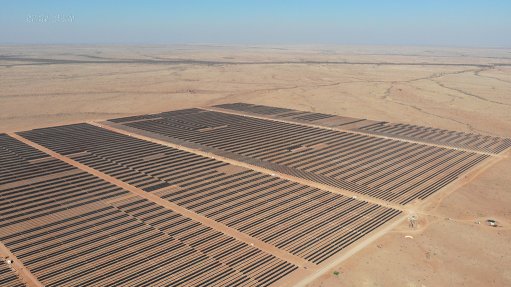Fibre roll-out ushering in new connectivity future for South Africa
The roll-out of fibre-to-the-curb (FTTC) promises to change the connectivity landscape of South Africa’s consumer and small-business markets, which have largely been neglected by the country’s prominent telecommunications companies, South African technology research company World Wide Worx MD Arthur Goldstuck tells Engineering News.
He points out that telecommunications companies, such as Telkom’s Business division and Neotel, have been offering high-speed fibre-optic Internet to large enterprises for a number of years, but their neglect of consumer and small-business markets have created an opportunity for other fibre-optic service providers to take advantage of the market gap. Of these, high-speed connectivity provider Vumatel – which completed its first suburban fibre connection in Parkhurst, Johannesburg, in April last year – is the most notable.
Vumatel CEO Niel Schoeman says the company has deployed fibre-optic cables past 20 000 homes to date, connecting 18 suburbs. It aims to increase the number of connected suburbs to about 50 by the end of the year by deploying fibre-optic cable past 100 000 homes in Johannesburg and Cape Town, amounting to an infrastructure investment of about R1-billion.
Vumatel will connect its first suburb in Cape Town in the first quarter of this year.
Goldstuck explains that, following Vumatel’s success in Parkhurst, the fibre service providers saw the significant potential for growth in the consumer and small-business markets. He highlights that, soon after Vumatel had been awarded the tender to install fibre-to-the-home (FTTH) in the suburb, Telkom “woke up from its slumber” and started its own FTTH roll-out in Bryanston.
“For a number of years, I have been arguing that Telkom was ideally positioned to undertake the FTTH roll-out. However, Telkom does not take significant risks and tends to be married to its installed base of technology,” he states.
He explains that Telkom’s risk averseness was first evident in its tentative approach to rolling out asymmetric digital subscriber line (ADSL) technology to replace the near-defunct integrated services digital network and dial-up services in the 2000s.
Leading the Way
Vumatel’s success in the fibre-optic arena is largely attributable to its developing an online ranking system, which enables residents from various suburbs in Johannesburg and Cape Town to express an interest in receiving fibre connectivity.
Schoeman explains that a suburb will be placed on a deployment schedule once its residents have expressed a minimum interest of 30 % in the online poll.
The strategy did not only provide the company with a lead-generating system but also helped market the company. “The online survey gives Vumatel tremendous negotiating power with resident associations within suburbs, as any association wanting to be seen as representing its residents will have no choice but to pursue fibre,” Goldstuck asserts.
He adds that Vumatel has also been geographically strategic in its market approach, as it favours a strategy of contiguous fibre roll-out to suburbs next to those that already have the infrastructure in place.
Schoeman explains that this strategy makes more sense, as deploying networks next to each other significantly reduces installation costs.
Goldstuck highlights that Vumatel’s excellent market strategy and its ability to “spark the emergence of an industry” were rewarded in November last year, with Schoeman receiving the 2015 IT Personality of the Year award at the Institute of Information Technology Professionals South Africa President’s Awards, which were held in Sandton.
Meanwhile, Goldstuck points out that Telkom is in a position to “cherry-pick” the suburbs it wants, owing to the telecommunication giant’s access to significantly more funds and its existing fibre grid. “Telkom’s resources and installed fibre grid give them huge potential to become the dominant player in the fibre arena of South Africa.”
More Affordable
Goldstuck says that increased consumer and small-business demand for fibre technology is mainly the result of the technology being more affordable and the dramatic drop in data costs.
About five years ago, a 100 mbs fibre line would have cost more than R20 000 a month in rent; the same line can currently cost as little as R1 000 a month.
Further, the increasing number of independent fibre-optic companies, such as Vumatel, Neotel and Dark Fibre Africa, entering the local market has not only highlighted the possibilities of the technology but also contributed to lowering costs and making the technology commercially more viable for consumers and small businesses.
Goldstuck says fibre-optic demand is most prevalent among middle- to upper-income earners, owing to the ability of the technology to take advantage of services, specifically video on demand (VOD), that require high- quality high-speed bandwidth.
It is, thus, no coincidence that the emergence of VOD companies in South Africa, such as South Africa-based multinational media and Internet company Naspers’ ShowMax and Internet streaming service Netflix, occurred at the same time as the increase in the fibre-optic service roll-out: “. . . these companies can see the fibre future in South Africa, which makes it viable to provide VOD.
The emergence of ShowMax in August came on the back of increased FTTC roll-out, while Netflix’s impending arrival in South Africa had prompted Naspers to offer its own VOD service to remain competitive.
Netflix was launched in South Africa earlier this month.
Goldstuck highlights that the improved bandwidth capabilities of fibre-optic technology will also improve videoconferencing capabilities, which will have a significant impact on consumers and small businesses that want to connect with people worldwide using high- quality video-streaming services.
Meanwhile, the mass roll-out of fibre will place continual pressure on other Internet technologies, such as ADSL, which could result in these technologies being accessible to significantly more people.
“With each new technology that comes to the fore and as more people embrace the technology, those companies that want to hold customers on to older technologies will have to compete on price and service,” Goldstuck says, predicting continual improvements in Internet services and prices.
He adds that, in the next three to five years, the popularity of fibre will force Telkom to rethink its ADSL pricing structure, which requires a deposit and an installation and connection fee, as well as a monthly phone line and ADSL rental cost. Pricing structures for fibre-optic services have, however, no monthly rental fee or deposit.
“If [the ADSL] pricing structure is not changed then, it will, in effect, become the poison that Telkom feeds itself, as people will see fibre-optics as the better option,” Goldstuck warns.
Connectivity & Development
Goldstuck explains that there are several economic scenarios that impact on the global telecommunications industry.
Industrialised nations, particularly those in Western Europe and North America, have a pervasive access to high-speed Internet tech- nologies such as fibre-optics and cable.
North America’s most significant advantage is that it can provide high-speed broadband over the same infrastructure through which consumers receive television broadcasts; Western Europe has fairly small geographical hurdles, which are easily overcome when installing fibre-optics infrastructure.
However, Goldstuck points out that there are still significant digital divides between the urban and rural populations in industrialised economies.
He notes that high-speed broadband is becoming a standard expectation for emerging industrial economies, particularly in Eastern European and East Asian countries, where mobile broadband services are well developed.
In South Korea, which is rated the best in high-speed Internet services, long-term evolution advanced (LTE-A) and fibre-optic are widely available, owing to densely urbanised populations of fairly affluent people.
Also in emerging markets, such as those in Israel, the UAE and South America, there is a great push to improve connectivity, and many of these countries are improving their competitiveness in the global telecommunications industry.
However, Goldstuck does not categorise emerging markets in Africa with those in the UAE and South America, as there is little movement in developing high-speed Internet services in these markets.
He points out that the top 20 countries with high-speed Internet, which are dominated by industrialised and emerging industrialised economies, have realised that high-speed Internet is an economic necessity that affords them a competitive advantage.
However, the leadership of emerging markets, such as South Africa, have not integrated this into their thinking and are unable to “associate surfing the Internet as an idea with using the Internet as an economic driver”.
Nevertheless, the fibre-optic service roll-out is likely to continue despite a lack of effective government strategies and initiatives.
Government has a broadband policy framework, which requires universal Internet access by 2030, but there has been little to no movement to improve the required infrastructure to meet this target.
Goldstuck concludes that the development of high-speed connectivity solutions has subsequently fallen to private enterprises, such as Vumatel, to propel South Africa into the future of connectivity and Internet access.
Comments
Press Office
Announcements
What's On
Subscribe to improve your user experience...
Option 1 (equivalent of R125 a month):
Receive a weekly copy of Creamer Media's Engineering News & Mining Weekly magazine
(print copy for those in South Africa and e-magazine for those outside of South Africa)
Receive daily email newsletters
Access to full search results
Access archive of magazine back copies
Access to Projects in Progress
Access to ONE Research Report of your choice in PDF format
Option 2 (equivalent of R375 a month):
All benefits from Option 1
PLUS
Access to Creamer Media's Research Channel Africa for ALL Research Reports, in PDF format, on various industrial and mining sectors
including Electricity; Water; Energy Transition; Hydrogen; Roads, Rail and Ports; Coal; Gold; Platinum; Battery Metals; etc.
Already a subscriber?
Forgotten your password?
Receive weekly copy of Creamer Media's Engineering News & Mining Weekly magazine (print copy for those in South Africa and e-magazine for those outside of South Africa)
➕
Recieve daily email newsletters
➕
Access to full search results
➕
Access archive of magazine back copies
➕
Access to Projects in Progress
➕
Access to ONE Research Report of your choice in PDF format
RESEARCH CHANNEL AFRICA
R4500 (equivalent of R375 a month)
SUBSCRIBEAll benefits from Option 1
➕
Access to Creamer Media's Research Channel Africa for ALL Research Reports on various industrial and mining sectors, in PDF format, including on:
Electricity
➕
Water
➕
Energy Transition
➕
Hydrogen
➕
Roads, Rail and Ports
➕
Coal
➕
Gold
➕
Platinum
➕
Battery Metals
➕
etc.
Receive all benefits from Option 1 or Option 2 delivered to numerous people at your company
➕
Multiple User names and Passwords for simultaneous log-ins
➕
Intranet integration access to all in your organisation





















